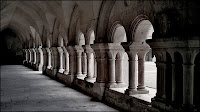A 19th century concert hall is not a bad location to muse about classical longings. Imagine a hall with two stories of balconies - each balcony pompously sculpted in the round, and flanked by velvety red curtains. Imagine rows of creaky seats with fading red upholstery. And light streaming in from a frosted glass ceiling, illuminating four graceful figures on the podium: three humans and a grand piano.
The pianist caresses the keyboard with swift fluidity and in front of the imposing black piano the soprano-singer in evening-dress sways ever so lightly to the melody. The tuxedo-clad violinist seems to stand guard, resting his bow on the violin’s strings, before launching into animated action.
And for a while all is harmonious perfection – the music of course, the pleasing ensemble of two instruments and a human voice. But also the visual grace of it, of those three figures gathered around the gleaming black piano. Formally (musically and visually), it’s a matter of a pleasing unity in multiplicity, of melodious lines, of variations. Emotionally it is about unrest and longing sublimated in melody. It is “rest tempered by movement – movement tempered by rest”(1).
Of course, it is about nostalgia too. A nostalgic longing for a cultivated society of noble taste & gracious urbanity, although such a society, in that ideal, pure & disinterested form may never have existed. Bourgeois snobbery & display and stifling etiquette surely have always been part & parcel of classical concert life. And granted, it’s also a nostalgic longing for the cultivated connoisseur I myself am not.
Frankly, I don’t know where and why I contracted that kind of classical longings – “ce désir en moi qui cherche sa patrie” (2). After all I lack a fully-fledged classical or aesthetic education and belong to the post-punk generation. And what with “classical culture” having become so discredited … But even though I'm aware that classical ideals may never have really existed as we imagine them, I do feel that the longing for them remains valid. The longing for a reconciliation between unrest and order as exemplified by classical aesthetics.
As Bonnefoy remarked upon the often derided neo-classical art: « la nostalgie que portait en soi cette sensibilité tardive est plus véridiquement perpétuable que l’héroique illusion de ce qu’on appelle une haute époque » (3).
And so I sat musing in-between the pieces. My classical longings fulfilled for awhile.
Even though this was just a 35 minutes lunch-concert, with French songs I do not really care for (4) ( and with even a few cloyingly sentimental operette lieder). And despite the very old lady exclaiming very, very, loudly at each good tune “ah, ça … ça c’est jolie!” (5) . And even though afterwards I had to cycle back to work through the pouring rain.

might there be such a thing as notes nostalgia?
(1) Panofsky’s definition of classical contrapposto in the visual arts
(2) Yves Bonnefoy , “that desire within me, searching for its home”
(3) in “Un rêve fait à Mantoue – L’humour, les ombres portées » - « perhaps the nostalgia contained in a late sensitivity/sensibility can last more truly than the heroic illusion of a so-called high period". You can imagine how I cherish that Bonnefoy phrase - it has become something of a talisman to me.
(4) hmmm, the sheer bourgeois frivolity of those 19th C. song-titles! – “Le Bonheur est chose légère” (Happiness is so light a thing - well fleeting I'd personally say or elusive, but light?? ) and “Violons dans le soir” (violins in the evening) , or still “Chanson de l’adieu”
(5) Ah, but she was sweet, really
(6) About the photo: not quite the grand piano in the above described concert hall, but a beautifully gleaming piano all the same, standing in the Liège Musée d’art Moderne, in a corner of the hall, in front of large windows looking out into a very nostalgic bourgeois park. The museum-building itself was the Belgian pavilion for the 1905 World Exposition. So qua mood and intention I dare hope the photo is in tune with the above musings.










